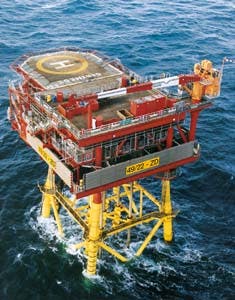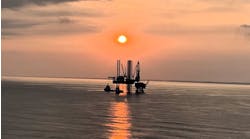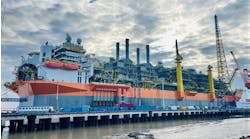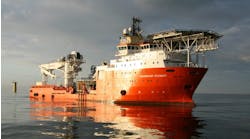Jeremy Beckman
London
Conoco's Ganymede platform in the UK southern gas basin will be among several installations supplying Wingas through the Interconnector pipeline.
Amalie, Adda in line for development
Two more Danish fields are closer to development, although neither could exactly be labeled fast-track. The problem for the Amalie Field partners, led by Statoil, is finding an available pipeline to export the gas and also to negotiate a sales agreement.
By current reckoning, the field's 3 bcm of gas and 6-12 MM bbl of condensate should be onstream around 2000. The reserves, discovered in 1991 in the northern Central Graben, would likely be produced through an unmanned wellhead platform tied to an existing installation with process facilities.
At one point, Adda, in the western Danish sector, looked a candidate for a STAR unmanned platform with up to three production wells. But Maersk has now submitted a development plan involving a one-well subsea tieback to the Tyra Field facilities 10 km away, probably not onstream before 1999. Reserves are put at 6.3 MM bbl of oil and 1 bcm of gas.
Kinsale Head enters expansion phase
Ireland's main producing offshore gasfield, Kinsale in the Celtic Sea, is set for expansion. Operator Marathon expected government approval to develop the South West Lobe in block 48/25 as a seven km subsea tieback to the host facilities. A test well in the accumulation last year flowed at over 23 million cf/d from three intervals.
Kinsale and the nearby Ballycotton Field (also Marathon) flowed gas at record levels of over 310 million cf/d in January, and are now expected to sustain production well into the next century.
Further north in the UK Irish Sea, Marathon has also been granted a second exploration licence by the Isle of Man government for block 112/24. This adjoins another, 1st Round block awarded last year, where Marathon is preparing to spud a first well.
BP has picked up two full and two part-blocks. Initially it intends to re-evaluate a well completed on this acreage in 1982. Gas was discovered, but reservoir quality was allegedly poor. BP also plans to re-interpret old seismic, and will finance an environmental study with the island's Port Erin marine laboratory.
NAM targets Waddenzee gas
The Dutch Ministry of Economic Affairs is reviewing applications for drilling permits in the Waddenzee, the contentious shallow water area off the country's northern coast. NAM has applied to drill six exploration wells, and looks to have a good commercial case for doing so. 3D seismic over the last year led to the reserves estimate being more than quadrupled to 220 bcm, all said to be recoverable from long-reach wells drilled from an onshore location. Feasible production looks unlikely before the next decade, however.
In the much shorter term, NAM has plans to tap a small gas accumulation south of the K14-FA1 platform. And PanCanadian Petroleum has been drilling two wells in nearshore Dutch block Q/13, first explored by Amoco in 1962.
The initial spud in this block encountered oil in a Lower Cretaceous-Upper Jurassic sandstone formation, but subsequent disappointments led to Amoco ceding the acreage. In 1994, NAM, as new operator of the block, made a second oil discovery south of the original find.
PanCanadian then exercised its rights to explore for oil within the Jurassic and younger horizons, but its first well in the current program, Q/13c, was abandoned as a duster. The second well is appraising one of the earlier discoveries.
On the median line with the UK, Lasmo Nederland has clinched its second third-party agreement for the Markham gas processing facilities. Output from Wintershall's new Windermere Field will be sent through an 8-in. pipeline to the Markham ST-1 platform, then onward through a 12-in. interfield line to the J6-A platform for processing, compression and drying, and final export to the Den Helder terminal.
Windermere has not actually gained UK sanction yet, but development drilling is expected to start next month, with first production early next year. Elf Petroland's new J3-Charlie Field was Lasmo's first third party client.
Pipeline progress heartens gasfield developers
Interconnector, the proposed 500 million pipeline link from Britain to Belgium, has moved two steps closer to reality. Firstly, agreement has been reached to re-site the gas compression station in British Gas' Bacton terminal: residents had vetoed the idea of giga-decibels in an area of open countryside.
Around the same time, Conoco UK concluded the first contract for supplies through the new pipeline with Germany's Wingas. Conoco will send over 1 bcm annually, initially from southern North sea fields such as Ganymede, Murdoch and the "V" cluster, but possibly also later on from Britannia.
This is a 10-year deal, with first deliveries due in 1998, once EMC has completed the pipelay. Wingas will build a new pipeline (WEDAL) to receive the gas from the Belgian/German border near Aachen.
Rig squeeze favors contractors
Drilling contractors continue to cash in as the available rig pool depletes. In Norway Smedvig has signed a letter of intent with Norsk Hydro for its largest ever drilling contract, worth a minimum of $236 million.
The deal secures third generation semis West Vanguard and West Delta for seven rig years for future exploration and development drilling off Norway, with options for a further seven rig years. West Vanguard has been working on the Oseberg Field: operator Hydro plans two further platform-based oil and gas developments to the east and south.
Transocean 8, a fourth generation semi, has been lined up for 30 days late this year for a handsome $4 million by Phillips. The rig will drill an exploration well somewhere in the Norwegian sector - possibly on Phillips' new 15th round acreage - with an option for a further well east of Troll.
Statoil has booked a record 11 rigs this year, 10 working in the Norwegian shelf, including a shared exercise with Saga in the southern Barents Sea. This rate of utilization will be maintained in 1997 and will likely rise thereafter, according to project manager, rig hire Per Haaland.
Current drilling development programs off Norway include Saga's Vigdis, where the second of three pre-drilled producer wells was recently completed at an average of 169 meters/day. This was unusually rapid by Norwegian standards, according to Saga's Ole Tangen. The well included a 1,700 meter horizontal section and was completed by drilling upwards again and out of the reservoir.
Copyright 1996 Offshore. All Rights Reserved.




